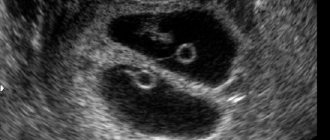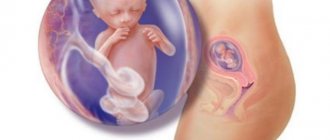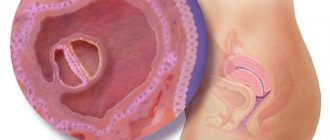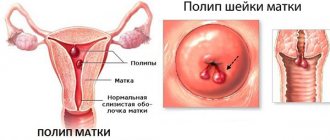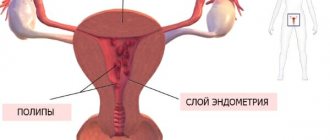When a desired pregnancy occurs, all expectant mothers want to reliably make sure that the fertilized egg is attached to the wall of the uterus and the formation of the unborn baby is happening normally. The most reliable and convenient way to confirm a positive pregnancy test is an ultrasound examination.
Despite the fact that a high-precision test strip, readily available in pharmacies, indicates the onset of pregnancy, and a qualified obstetrician-gynecologist is able to recognize the symptoms of a “pregnant uterus,” only the final ultrasound data confirms the fact of gestation. That is why, in the case when a woman believes that she managed to get pregnant, but the ultrasound does not show the fertilized egg, future parents are perplexed.
In connection with this phenomenon, they have a question: can a diagnostician not see a pregnancy on an ultrasound? In our article, we want to provide information about at what period of delay in menstruation it is possible to confirm the completion of the conception process, when an ultrasound scanner will allow the doctor to see the embryo, and whether it is possible not to see pregnancy on an ultrasound.
How does fertilization occur?
Fertilization is a complex process consisting of several stages. Among them are:
- determining ovulation to increase the chance of successful fertilization;
- entry of sperm into the female genital area;
- fusion of sex gametes to form a zygote;
- movement of a fertilized egg from the fallopian tubes into the uterine cavity;
- attachment and implantation of the embryo into the endometrium.
The time during which fertilization must occur is determined by the life cycle of the gametes. The egg is capable of receiving sperm within 12-24 hours. Sperm can remain active in the body for 7 days. Therefore, determining the period of ovulation is important for successful fertilization.
Factors
The viability of the female reproductive cell depends on several basic criteria. One of the main ones is the safety and usefulness of the genetic material and structural proteins in it. The saturation of substances that accumulated during the preovulation period of maturation also has a direct effect.
The individual characteristics of the female body are also very important, since the basic life program of cells is different for everyone.
Several factors can affect the progress of an egg. As a rule, they also affect the lifespan of the cell. These include:
- alcohol consumption. Alcohol is a mutagen, meaning that it affects the hereditary information in eggs. According to statistics, it has been proven that during sexual intercourse that occurs while intoxicated, there is a high probability of ectopic pregnancy.
- Smoking. This bad habit contributes to vascular spasm and blockage, resulting in a decrease in blood supply to the organ. This leads to failures in the release of eggs, as well as a decrease in their number. After all, unlike men, women have a certain number of reproductive cells for their entire lives. The ovarian reserve is formed during intrauterine development.
- Special drugs - contraceptives.
- Chronic intoxication in the body.
- History of infectious and/or inflammatory diseases.
- The effects of radiation exposure on the body.
A woman's age also plays a big role in the viability of her eggs. The older the woman, the less likely she is to conceive further, as genetic defects gradually accumulate in the cells. All this leads to age-related infertility and hormonal imbalance - menopause.
Period of egg fertilization
The period of fertilization of the egg is determined by the period of its viability. After the mature oocyte leaves the follicle, the germ cell retains the ability to fertilize for 12-24 hours. During this time, the sperm must penetrate the egg. If this does not happen, the oocyte completes its life cycle. The next opportunity to conceive will come in a month.
Obstetric term
In this calculation, the pregnancy period is counted from the moment the last menstruation begins (the first day). The characteristics of the female body are not taken into account here. During the first two weeks you cannot talk about pregnancy, because fertilization is impossible at this time. However, if conception is successful, the period is calculated from this date. The fact is that according to this method, pregnancy begins from the moment of maturation, and not fertilization of the egg, which has a certain logic.
Using this method, the date of birth is determined, as well as the onset of maternity leave. Even if this method is not entirely accurate, it is, as a general rule, what gynecologists use in their calculations. To answer the question of what day of delay an ultrasound shows pregnancy, we will use the obstetric calculation method.
Fertilization symptoms
In order to determine the presence of pregnancy, it is necessary to take a blood test for hCG 14 days after fertilization. In addition, there are symptoms, the presence of which may indicate successful conception.
Gastrointestinal disorder
The first signs of fertilization may be associated with dysfunction of the gastrointestinal tract. This is expressed by the following symptoms:
- feeling of nausea;
- periodic vomiting;
- fullness and bloating;
- disturbance of taste sensations.
These symptoms are characteristic of the period when the embryo is implanted into the uterine cavity.
Cystitis
Pregnancy is accompanied by hormonal changes. This can provoke a weakening of the body's protective functions. With reduced immunity, the chance of infection increases. Most often the urinary system suffers with the development of cystitis.
Change in basal temperature
High basal temperature numbers throughout the second half of the menstrual cycle may indicate pregnancy.
Change in hCG level
A reliable sign of successful fertilization of the egg after ovulation is an increase in the level of hCG in the blood. This analysis is carried out 2 weeks after conception. A sharp increase in concentration indicates the onset of pregnancy.
Chest pain
During pregnancy, hormonal levels change. This affects the condition of the mammary glands. Successful fertilization leads to an increase in breast size and sensitivity. These symptoms are typical for the onset of menstruation. However, during pregnancy they become more pronounced and lasting.
Psychological changes
Emotional lability is a characteristic sign of pregnancy. The woman becomes tearful, irritable, and anxious. Frequent mood changes are explained by hormonal changes in the body.
Bloody issues
In this case, we mean implantation bleeding that occurs after the embryo has successfully implanted into the uterine wall. The discharge is scanty and spotty. Often perceived as the beginning of menstruation. If there is severe bleeding that continues for a long time, it is recommended to consult a doctor.
Bloating
Increased gas formation and bloating often appear in the first weeks of pregnancy. They usually go away towards the end of the menstrual cycle. In some cases, intolerance to certain foods or smells occurs. New eating habits may emerge.
Abdominal cramps
The appearance of nagging pain in the lower abdomen and periodic cramps is characteristic of pregnancy. Normally, symptoms go away after a few days. If pain increases, you should consult a doctor.
Fatigue
Hormonal imbalance is the cause of many changes that occur in the body of a pregnant woman. It leads to fatigue, drowsiness, and fatigue.
Increased PMS symptoms
Often the first symptoms of pregnancy are similar to those of PMS. If clinical signs become pronounced and prolonged, this may indicate pathological attachment of the fetus. In this case, a visit to the attending physician is mandatory.
Stomach ache
The first weeks of pregnancy are characterized by periodic nagging pain in the lower abdomen. In some cases, pain may spread to the lumbar region.
Decreased immune defense of the body
To ensure that the woman’s body does not perceive the embryo as a foreign body, the body’s protective functions decrease. This allows the embryo to successfully attach and penetrate the endometrium.
Delayed menstruation
The most characteristic sign of pregnancy. If menstruation does not come on time, then the chance of successful fertilization increases. Pregnancy can be definitively confirmed with a blood test for hCG levels.
Nausea and vomiting
Dysfunction of the gastrointestinal tract and hormonal changes in the body provoke the appearance of nausea. Vomiting is also a characteristic sign of pregnancy.
Will an ultrasound show pregnancy before the delay?
Many girls who dream of becoming mothers are concerned about whether an ultrasound will show pregnancy before their period is missed. Experts say this is quite possible. It all depends on the characteristics of ovulation. It doesn’t happen on everyone’s schedule at the same time. For some, it may be earlier than the due date, for others, on the contrary, later, and for some, even 2 eggs are released during the cycle. This is completely normal. If ovulation occurred earlier, then fertilization occurred not 14 days after the start of the last menstruation, but earlier. In this case, a specialist can detect pregnancy before the delay, but only with the help of a vaginal ultrasound.
The article discussed all the intricacies of the question of how long after the delay an ultrasound will show pregnancy. If you are planning a pregnancy, you need to track the duration of your cycle, menstruation, and also listen to your body. Remember that nothing happens within us according to a pattern. Everything is individual!
Signs of conception in the first week
The first week is accompanied by the final attachment of the embryo to the wall of the uterus. The first symptoms after conception may be:
- bloody discharge from the genitals;
- nagging periodic pain in the lower abdomen;
Discharge indicates the successful implantation of the embryo into the endometrium of the uterus. They go away on their own after a few days. If pain and bleeding persist for a long time, you should consult a doctor.
Embryo parameters
In the first days after conception, the embryo does not look like a person, rather like a rounded shell with a tail. But as it grows, its appearance changes, and if at 5–7 weeks the embryo resembled the letter “C”, then after a week on an ultrasound the doctor will see the head and arms of the embryo as a separated part of the body.
The fertilized egg normally has the shape of an oval and is dark gray in color. So that the gynecologist can monitor the baby’s development on an ultrasound, 2 indicators of this period are measured:
- SVD (diameter of the fertilized egg along the internal contour);
- KTR (coccygeal-parietal size).
| Duration, weeks | 4 | 5 | 6 | 7 | 8 | 9 |
| SVD, mm | 10 | 18 | 22 | 24 | 30 | 33 |
| KTE, mm | 2-3 | 4-5 | 7-9 | 11-15 | 16-22 | 23-30 |
At what week the embryo will be visible on an ultrasound depends on many factors, which is why if the fetus is not visible, then you need to wait a couple of weeks and repeat the ultrasound session.
Symptoms of conception during fertilization of the egg in the third and fourth weeks after fertilization
The third and fourth weeks of pregnancy are accompanied by a pronounced symptomatic picture. During this period, the embryo has successfully implanted into the wall of the uterus and begins active growth.
The main symptoms of pregnancy are:
- emotional lability;
- increase in size and the appearance of soreness of the mammary glands;
- drowsiness;
- fatigue;
- bloating;
- disruption of the gastrointestinal tract;
- libido change.
Signs of conception by day
The first two weeks after fertilization are characterized by active changes in the body. The embryo goes a long way from attachment to the endometrium to the beginning of the formation of internal organs. Let's look at the main symptoms of successful egg fertilization by day.
First day
The sperm travels through the fallopian tube to the egg. After this, the gametes merge to form a zygote. This period is not accompanied by any clinical symptoms.
The third day
It is characterized by the body’s readiness for embryo implantation, which is accompanied by hormonal changes. In this regard, a feeling of nausea, fatigue, headache, and loss of appetite appear.
Fourth day
After the sex cells have fused to form a zygote, it moves into the uterine cavity. During this period, abdominal discomfort, a feeling of fullness, and increased gas formation may appear.
Fifth day
On the fifth day, the embryo is implanted into the wall of the uterus. The process takes several days. If the embryo remains in the fallopian tube, an ectopic pregnancy develops. This is accompanied by an increase in body temperature, chills, sweating, and pale skin.
Sixth day
If there is pregnancy, on the 6th day there is an increase in basal temperature. The woman feels discomfort in the lower abdomen. The symptoms are similar to those of menstruation.
Seventh day
Embryo implantation may be accompanied by the appearance of bloody discharge from the genitals. They are meager in nature and go away on their own.
Eighth day
Hormonal imbalance leads to severe fatigue, drowsiness, fatigue, headaches and dizziness.
Ninth day
This period is characterized by the presence of a small amount of bleeding and signs of hormonal changes.
Tenth day
In a normal pregnancy, the process of embryo implantation is completed on the 10th day. This can be confirmed by a blood test for gonadotropin hormone.
Eleventh day
As a rule, PMS symptoms appear on the 11th day of the menstrual cycle. These include emotional lability, headache, sensitivity of the mammary glands and an increase in their size. If these signs are absent, then most likely the pregnancy is developing successfully.
Twelfth day
Dyspeptic symptoms are added to the clinical signs. These include vomiting, increased sensitivity to smells, feelings of nausea, and changes in taste habits.
Thirteenth day
Hormonal changes lead to pronounced changes in the mammary glands. They increase in size and become painful on palpation. In some cases, slight discharge from the nipples is allowed.
Sixteenth day
This period is characterized by the formation of the nervous and skeletal system of the fetus.
When does an ultrasound scan show an embryo?
The earliest time you can reliably see pregnancy on an ultrasound is the fifth week. A good doctor using high-quality equipment will be able to examine the fertilized egg, the embryo in it (it will look like a small dark strip 3-5 mm long), amniotic fluid; measure it, evaluate the shape and listen to the heartbeat of the embryo. A multiple pregnancy can be seen with confidence at a later date - at about 8-9 weeks.
What does it mean if it is not detected or malformed
If the doctor cannot see the fertilized egg by ultrasound and there are no other signs, such as thickening of the mucous layer of the uterine walls, this may mean that either fertilization has not occurred, or the period is still too short. But also the absence of an egg in the uterus may mean that it has implanted in the fallopian tube or somewhere else, and an ectopic pregnancy is life-threatening for the woman.
There can be many reasons for deformation. The most common is uterine tone. In the absence of pain, pulling sensations in the abdomen and lower back, bleeding and dilatation of the cervix, this condition is not dangerous - when the muscles relax, the fertilized egg will take the correct shape. But if the change in shape is accompanied by such unfavorable symptoms, this means an immediate threat of miscarriage and requires immediate action. In many cases, timely therapy can save the pregnancy and allow the woman to carry and give birth to a healthy child.
But it may also happen that the deformation is caused by the death of the embryo (frozen pregnancy), anembryony (absence of an embryo in the egg) or a tumor that has developed on the chorionic layer of the egg. Such tumors can be benign or malignant and lead to the death of the embryo. In such cases, the woman is cleaned and sent for rehabilitation.
In what cases is repeated ultrasound examination prescribed?
If a pathology is suspected, a repeat examination is ordered to confirm or refute doubts. It is best to undergo an examination by another doctor, since mistakes at such an early stage of pregnancy occur often - due to the doctor’s carelessness, due to poor-quality equipment, or due to incorrect diagnosis.
You will also have to undergo an ultrasound again if, for some reason, during the first examination it was not possible to listen to the heartbeat of the embryo or the period does not allow you to distinguish the embryo.
It is not advisable to do an ultrasound every 2-3 days; a repeat examination after 1-2 weeks is sufficient. Before this period, an ultrasound examination is prescribed only if there is reasonable suspicion of an ectopic pregnancy.
How many days after conception do real pregnancy symptoms appear?
The first real signs of pregnancy appear after the embryo implants into the endometrium of the uterus. Until then, all symptoms are subjective.
The first days after fertilization are not accompanied by specific clinical manifestations.
The severity of symptoms will increase as the embryo grows. Experts note that at 5-6 weeks of gestation, a woman can determine the presence of pregnancy without a test by the corresponding symptoms.
Transabdominal examination
Not all women have a positive attitude towards the vaginal method and use a more outdated method - abdominal examination. When will an ultrasound show pregnancy after a delay in this case? Compared to the vaginal method, such an examination is less informative. In the best case, pregnancy will be visible at the 9th obstetric week of pregnancy. This is only possible when using good equipment. Otherwise, the diagnosis will show a false negative result.
How many days after the delay will an ultrasound show pregnancy with 100% accuracy using the abdominal method? Under these conditions, pregnancy will be noticeable only at 9-12 obstetric weeks. Such an ultrasound examination is already the first planned one. It will be possible to see a full-fledged embryo with the first signs of life and nascent organs.
How does fertilization occur?
A sufficient amount of time passes from the moment of fusion of germ cells until the formation of an embryo. Experts distinguish several stages of fertilization.
Moment of fertilization
After completion of sexual intercourse, a sufficient number of sperm enters the woman’s body. Not all of them enter the uterine cavity. Many are retained by cervical mucus from the cervix.
- Sperm that have passed the barrier penetrates the area of the fallopian tubes. There, an egg awaits them, ready for fertilization.
- Thanks to a special secretion contained in the female genital tract, the acrosomal membrane is weakened. This allows the sperm to penetrate the egg.
- In order to destroy the protective membrane of the oocyte, sperm secrete the enzyme hyaluronidase.
- After all barriers are destroyed, gamete fusion occurs.
Zygote formation and further division
The fertilization process takes some time. After the sperm enters the egg, its active division occurs. When the oocyte reaches the required size, a zygote is formed. It contains genetic material received from both parents. The sex of the unborn child is determined by the chromosomal makeup of the sperm. If it contains only X chromosomes, it will be a girl. If there is a Y chromosome, then a boy will be born. The zygote moves from the fallopian tube into the uterine cavity for further attachment to the endometrium. Throughout its movement, the fertilized egg continues to divide. The final stage of this process is the blastocyst.
Blastula implantation
The blastula's job is to produce hCG, which facilitates the successful implantation of the embryo into the endometrium. At the moment when the blastula is ready to attach to the wall of the uterus, it develops into the state of a fertilized egg. After implantation, the embryo begins to feed on substances coming from the mother's bloodstream. As pregnancy progresses, the placenta develops. She begins to produce large amounts of hCG. A few days after implantation, the first clinical symptoms of pregnancy appear.
Formation of the fertilized egg
The first stage of the cycle that a reproductive cell goes through is the release of the egg from the follicle. Usually 3-4 follicles mature, but only one egg passes through a woman's fallopian tubes during ovulation.
The growth and development of a new life begins with the fusion of an egg and a sperm. Immediately after ovulation and fusion, a protective membrane forms around the egg.
This outer protective layer around the embryo will later develop into the amniotic sac containing amniotic fluid.
In the early stages of pregnancy, during an ultrasound, you can see the formation of an ovoid shape of small diameter. This is the fertilized egg. The first stage of its development is the morula, consisting of 12-32 blastomeres formed as a result of division of the zygote, which turn into a compact ball.
As the cells multiply, the embryo continues to move through the fallopian tubes until it attaches to the mucous wall inside the uterus. After this, the outer layer of the membrane begins to produce hCG (chorionic gonadotropin hormone), which is one of the first indicators of a woman’s pregnancy. All this time, the fetus is fed from the internal resource of the egg. In the process of further development, the attachment site is transformed into the placenta. At this time, to prevent infection, a mucous plug is formed, which closes the entrance to the uterus. This whole process takes about two days. If the embryo does not attach to the wall of the uterus, then a miscarriage occurs along with menstruation at the end of the cycle, and often the woman does not even know that she was pregnant. In the next cycle, the egg is released from the follicle again, ovulation occurs, and the whole process is repeated again.
What does a fertilized egg look like, structure:
- Villous membrane, chorion;
- Amnion (amniotic sac or membrane of water);
- Embryo.
It is difficult to see exactly what the fertilized egg looks like even with the help of an ultrasound. Due to its small diameter, the embryo is difficult to detect inside the uterus if a woman is pregnant for less than a month.
It happens that even at a period of 6-7 weeks the embryo is not visible inside the egg - this may indicate a non-developing pregnancy. An empty ovum is quite rare and is often a symptom of genetic disorders in the woman or her partner.
Pregnancy test
Experts recommend performing a pregnancy test 14 days after fertilization. This time is enough for the amount of hCG in the body to increase. In order for testing to be most effective, it must be performed three times. If the test is done too early, there is a risk of getting a false negative result. This will cause psycho-emotional stress, which will negatively affect the condition of the female body. A negative result during a pregnancy test can occur in the following cases:
- the embryo failed to attach to the endometrium;
- taking hormonal medications that can distort test data;
- defective test.
The most reliable test to confirm pregnancy is a blood test to determine the level of hCG 2 weeks after fertilization.
How does it change after implantation?
Implantation of the fertilized egg occurs in different ways; a fertilized egg can attach on the 4th day or on the 9th.
The production of hCG begins from this moment, and a daily increase in this hormone is observed:
- Day 1 – 2-10 mIU/l;
- Day 2 – 3-18 mIU/l;
- Day 5 – 11-45 mIU/l;
- 10th – 68 – 400 mIU/l.
On the 20th day from the date of implantation, hCG will already be 4200 – 15600 mIU/l, and on the 30th day – 19000 – 78000 mIU/l. At such a rapid pace, the growth of the hormone continues until 11-12 weeks of pregnancy, and then begins to gradually decrease.
Excessive levels of hCG against the norm may indicate the presence of such difficulties:
- multiple births;
- diabetes mellitus;
- cancer;
- pathologies of fetal development.
A lag in hormone levels from standard values may indicate the following reasons:
- ectopic pregnancy;
- threat of abortion;
- placental abruption;
- fetal death, etc.
Important! If abnormalities are suspected, the doctor will prescribe additional tests, including blood tests for other hormones. Only in combination with other results will a specialist be able to suspect pathologies of fetal development or genetic diseases, and to confirm such an unfortunate fact will require the use of more serious methods.
Indirect symptoms
This group of pregnancy signs is subjective. They do not always indicate successful conception. Indirect symptoms include:
- decreased appetite;
- change in taste habits;
- nausea and occasional vomiting;
- increased sensitivity to various odors;
- emotional lability;
- weakness, increased fatigue;
- drowsiness;
- frequent urge to urinate;
- the appearance of pain and an increase in the size of the mammary glands;
- increase in abdominal size;
- the appearance of pigmentation in the nipple area.
The above symptoms may appear during the premenstrual period or during ovulation. A reliable sign of pregnancy is a blood test for hCG.
Does ultrasound show baby's gender?
The appearance of primary sexual characteristics in the fetus begins in the second trimester.
The sex of the child is usually determined at 20 weeks of pregnancy and later, when the likelihood of error is minimal. In the first trimester, some experts can guess the baby’s gender based on the heart rate, which differs slightly between female and male fetuses. Making assumptions about heart rate is an unreliable method that is taken seriously only by certain specialists. It is possible to accurately determine gender only by external signs.
In the early stages, it is impossible to determine gender using ultrasound; if necessary, it is recommended to undergo other types of research, for example, a blood test. Such an analysis is prescribed for serious genetic pathologies in the family that are transmitted only to a child of a certain sex. Additional methods to help determine pregnancy
There are many ways to determine pregnancy other than ultrasound. They are used not only separately, but also in addition to ultrasound, when the result seems doubtful to the specialist. Signs of the birth of a new life can be direct and indirect. Direct indicators of pregnancy include:
- positive pregnancy test;
- the level of human chorionic gonadotropin in a woman’s blood is above 25 and continues to rise;
- During the examination, the doctor confirms the increase in the size of the uterus.
Indirect signs do not occur in every woman; their appearance is not always associated with pregnancy. You can verify the development of the embryo if, along with one of the direct signs, the following are present:
- drowsiness;
- nausea;
- sudden change of mood;
- breast swelling and increased sensitivity.
The first sign of pregnancy is considered to be the absence of menstruation. This sign cannot be considered reliable, since such a malfunction can be caused by various problems in the body.
Determining pregnancy by ultrasound is a reliable way to find out about your new position. For accurate results, it is necessary to wait for the appropriate period; this will not only ensure the presence of an embryo, but also find out about the normal development of pregnancy. The study helps determine the birth of a new life, as well as suggest the characteristics of the course of pregnancy.
